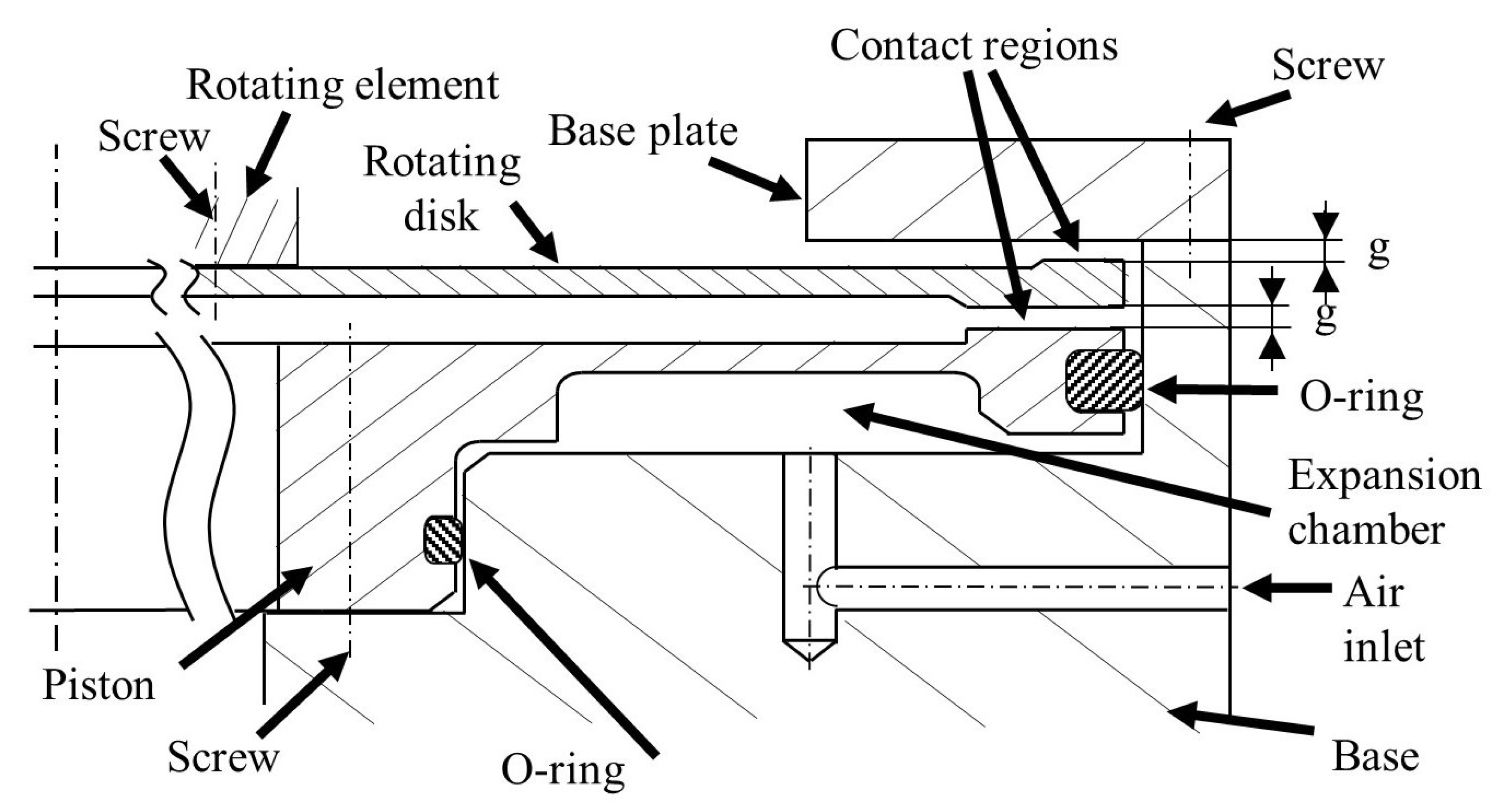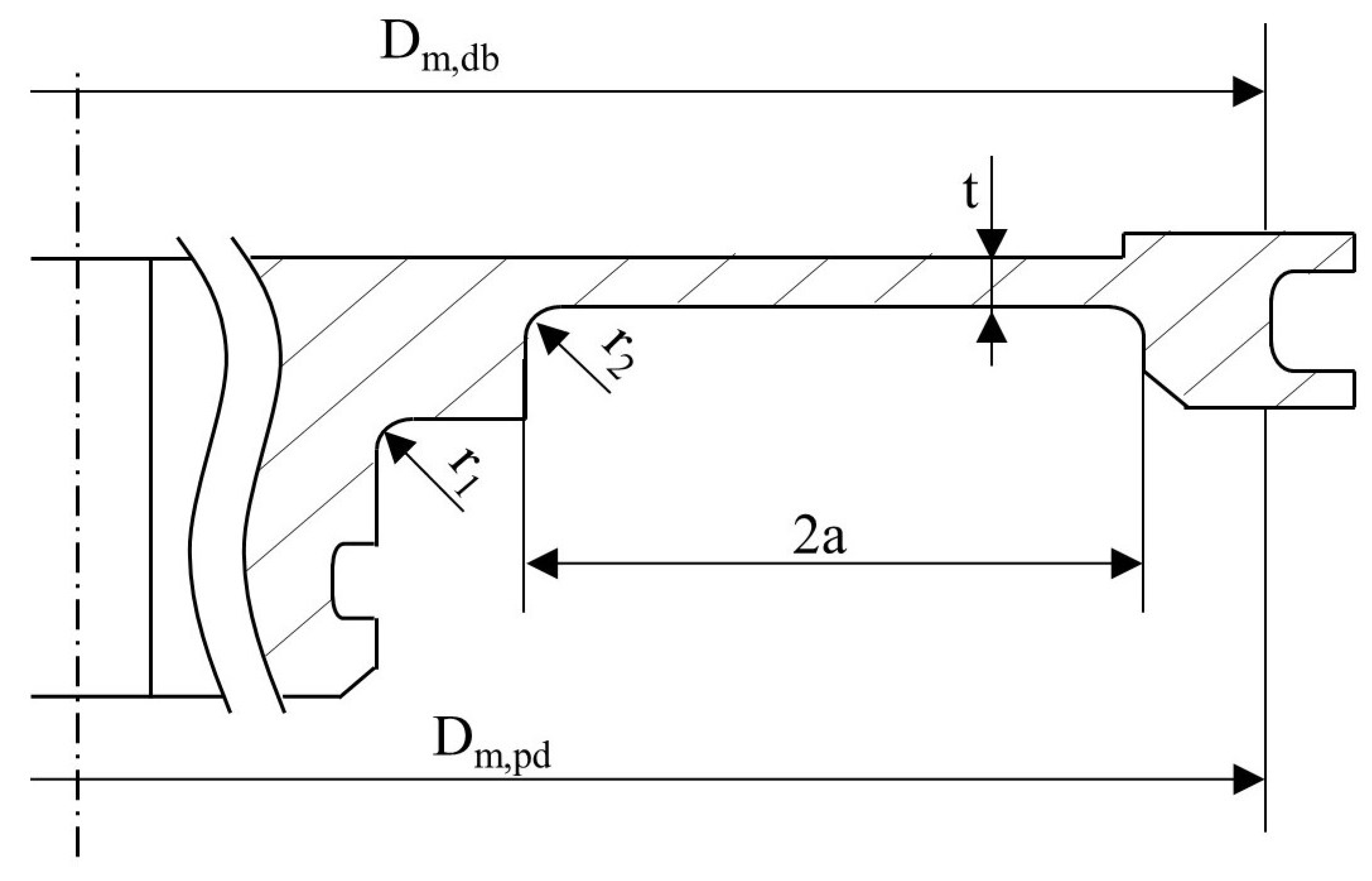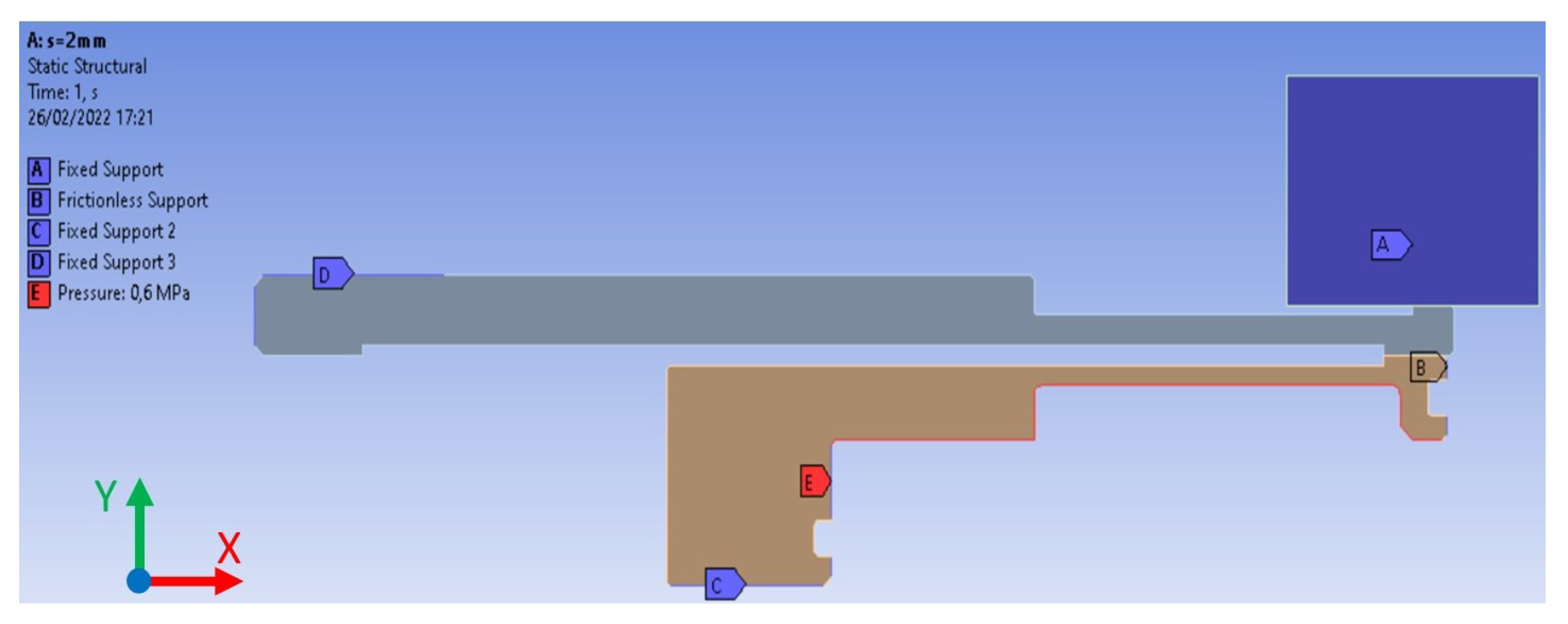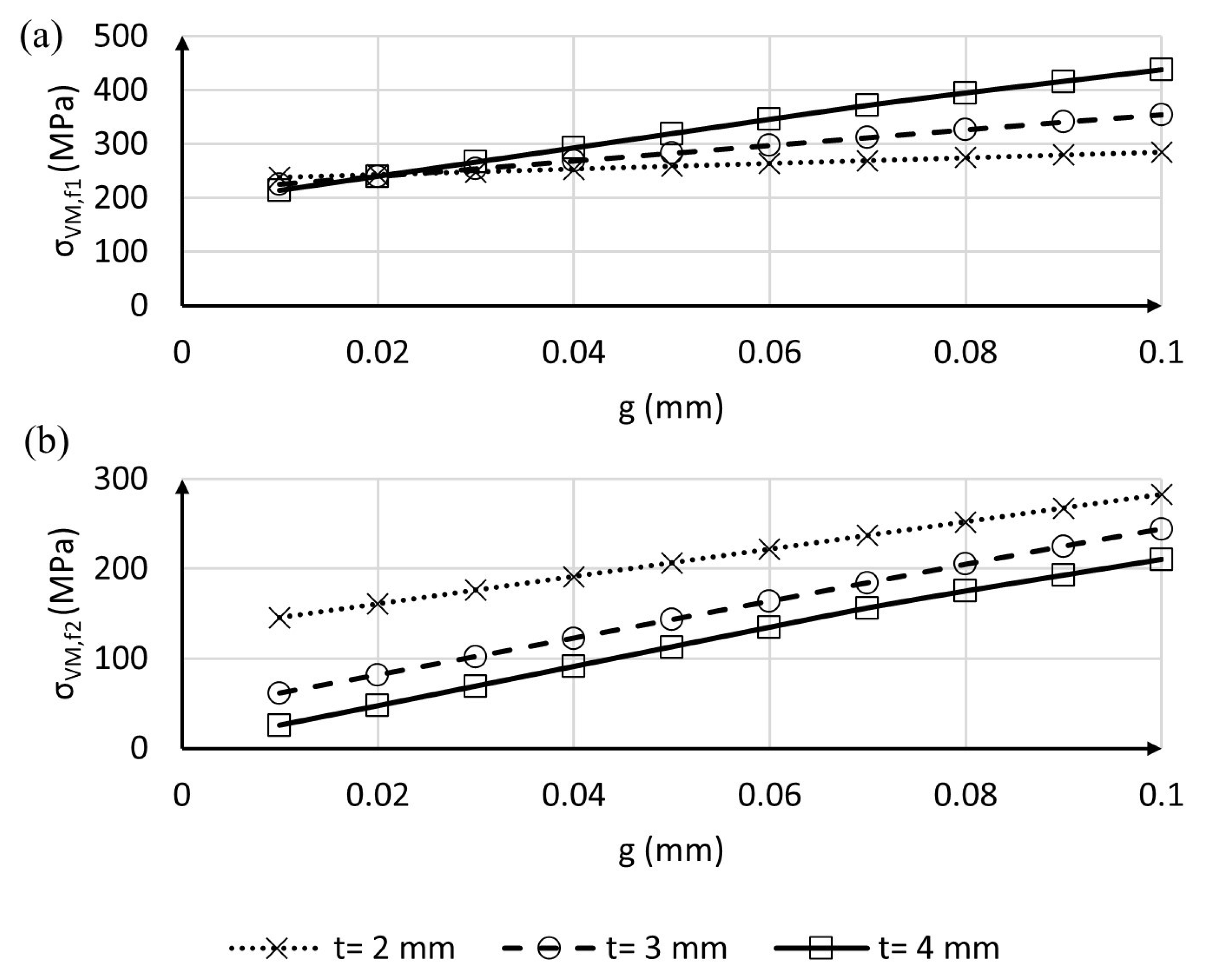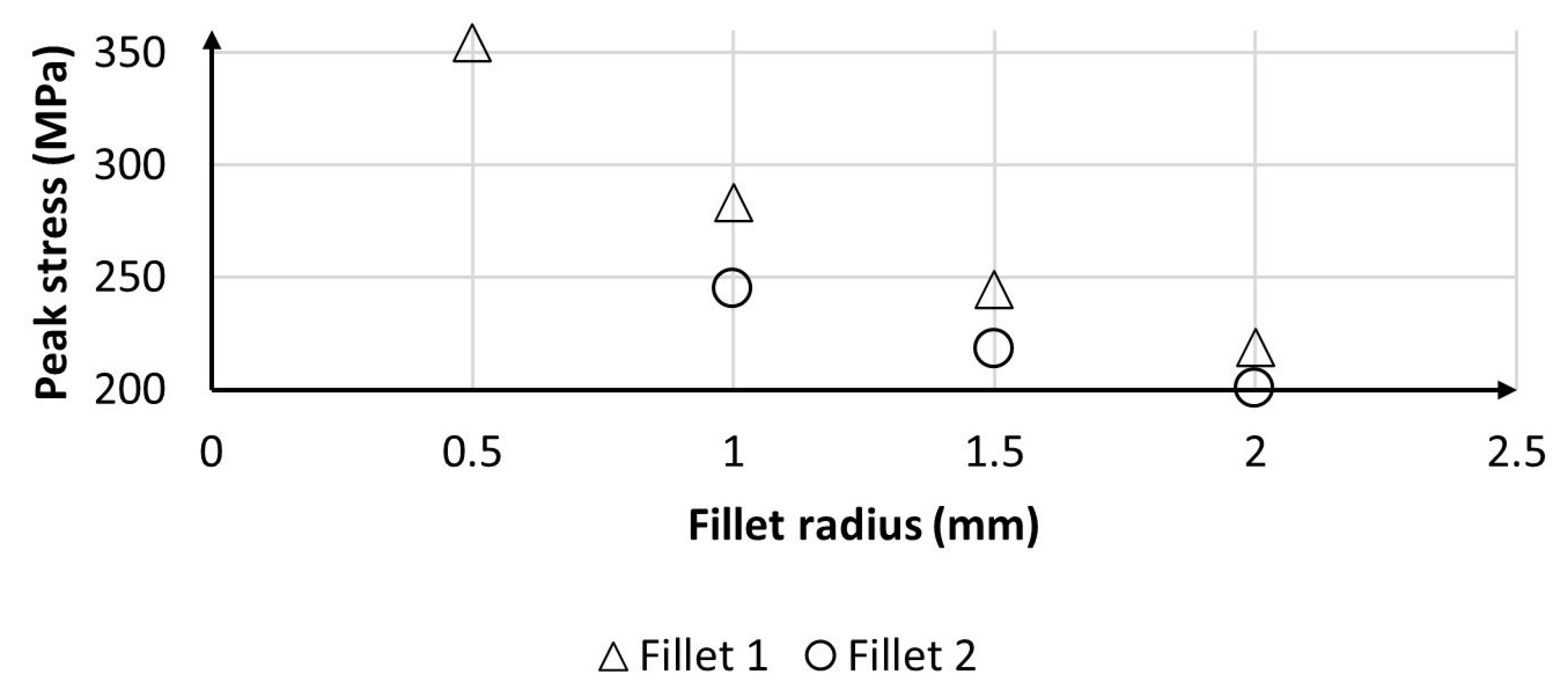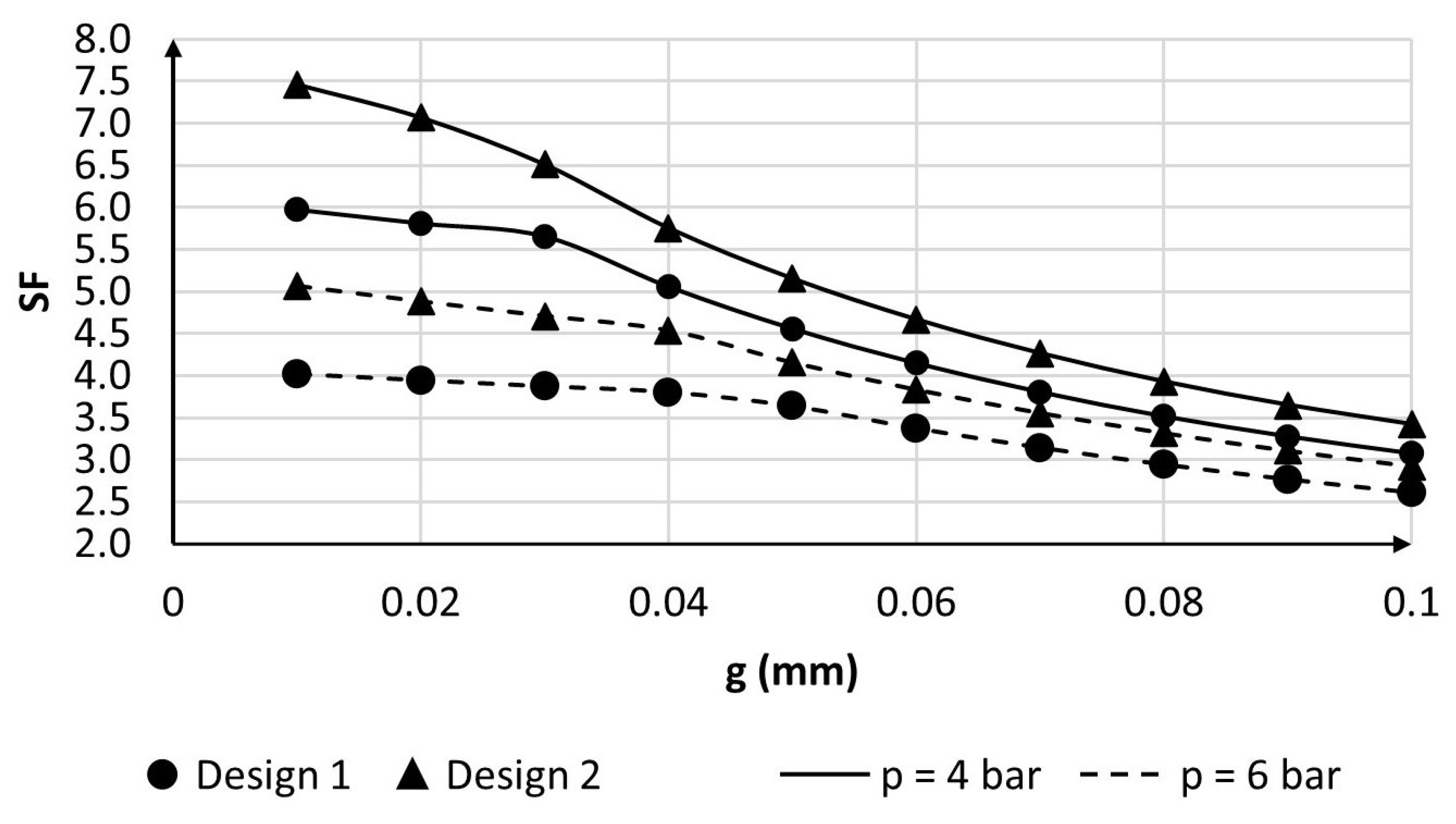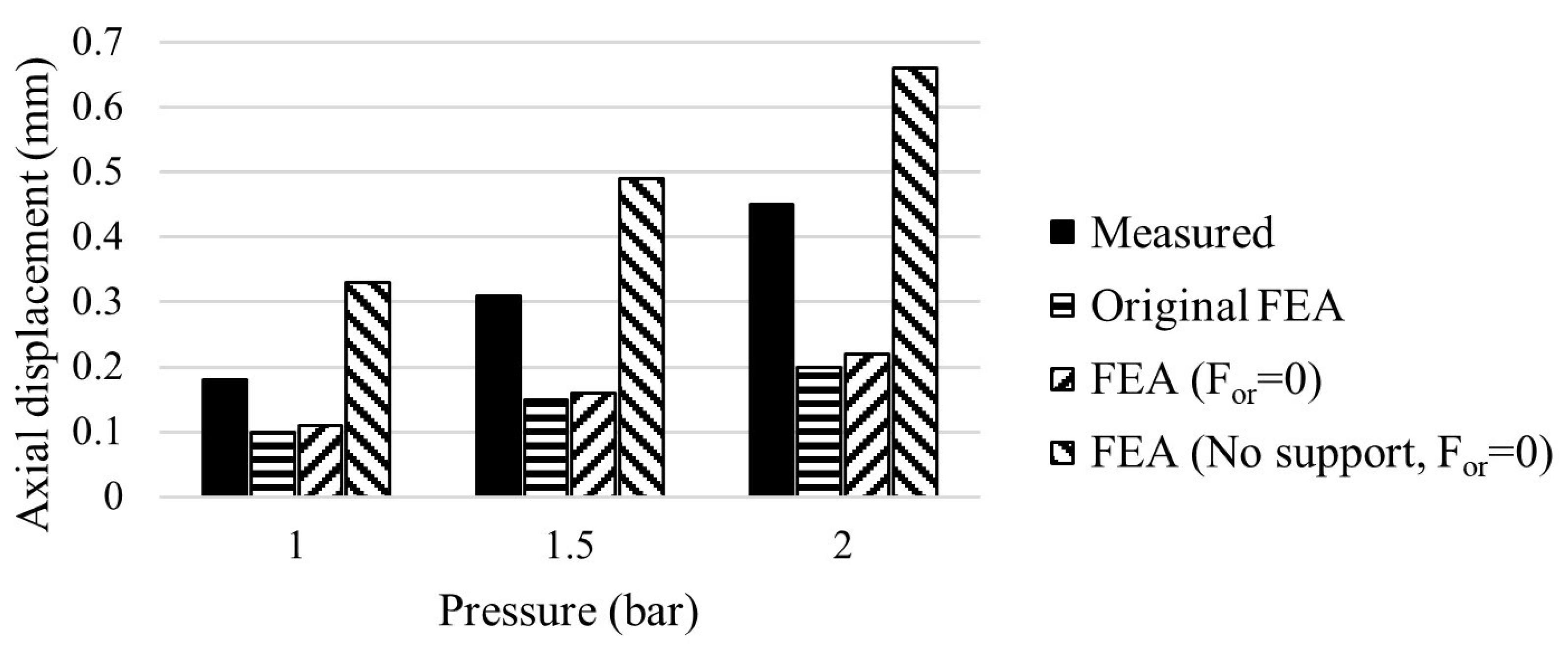3.1. Effect of Gaps between Fixed and Rotating Elements
Table 2 summarizes the values of force calculated at the two interfaces, namely piston-disk and disk-plate, for different values of the initial gap g.
When increasing the gap, the force applied to the piston-disk interface decreases since more energy is spent on the elastic deformation of the piston. As can be highlighted in
Table 2, even small variations in the gap determine a sharp drop in the force applied to the disk. This finding is particularly significant since, as introduced in the previous section, the real system may suffer from even small variations in the actual gap between elements due to geometrical, dimensional and assembly uncertainties. Such an issue becomes even more relevant in the case of large disks, where tight dimensional tolerances can be hardly obtained.
As previously described, the role of the piston is to deform the disk and put it in contact with the base plate. The force generated between the disk and the base plate is then responsible for the clamping torque acting on the system. Therefore, the difference between the force applied by the piston on the disk and that applied by the disk on the base plate consists in the force necessary to deform the disk. To better understand the effect of the gap on this dissipation,
Figure 5 plots the percentage of the piston-disk force used for braking and deforming the disk. As it can be seen, in the case of a 0.01 mm gap the force applied to the disk by the piston is almost entirely transmitted to the plate, with a loss of around 2.6%. On the other hand, in the case of a 0.1 mm gap, 77% of the force is spent to deform the disk before touching the base plate.
As mentioned in
Section 2.2, the finite element model is used to calculate the maximum stress on the piston considering an internal pressure of 6 bar. Specifically, the equivalent von Mises stress is investigated.
Figure 6 plots the peak values of equivalent stress
and
acting on the first and second fillets, respectively, at p = 6 bar. The maximum equivalent stress
on the piston membrane, namely the region of the piston with thickness t (see
Figure 2), is also reported. It is possible to notice that the stresses on the two fillets increase linearly with the gap but with different slopes. Particularly, a more severe effect of the gap on the peak stress on fillet 2 can be observed. The maximum stress on the membrane presents a non-linear dependency on the gap. It is possible to observe that this value is always lower than those calculated on the fillets due to the effect of stress concentration.
3.2. Effect of Membrane Thickness
The plots in
Figure 7 show the variation of peak stress on the two fillets with the gap for different values of thickness t. In the case of the first fillet, increasing the thickness of the disk determines a more severe growth in stresses when the gap increases. Particularly,
Figure 7a shows that, for gaps higher than 0.03 mm, thicker disks suffer from more relevant peak stresses. On the contrary, the maximum stress calculated on the second fillet is always lower for higher values of t (see
Figure 7b).
Table 3 reports the values of clamping torque for all the investigated combinations of thickness and gaps. It is worth mentioning that in the case of t = 4 mm and g ≥ 0.07 mm the force
is null, i.e., there is no contact between the disk and the base plate. In other words, the pressure applied by the incoming air is not sufficient to deform the disk enough to put it in contact with the fixed element of the system. This value of thickness has been thus excluded from the following analyses. Further, as mentioned in the previous sections, the manufacturing and assembly of the clamping system are affected by errors which make it hard to achieve tolerances below 0.05 mm. For this reason, the following analyses will be focused on the range from 0.05 mm to 0.1 mm.
3.3. Effect of Fillet Radius
In the original design, the radii
and
of the first and second fillets are equal to 0.5 mm and 1 mm, respectively. As well known, the concentration of stresses is strongly affected by the fillet radius, becoming more severe for small values. Therefore, a sensitivity analysis has been carried out by increasing the radius of each fillet separately and monitoring the corresponding variation in peak stress and clamping torque. The geometry with t = 3 mm has been considered. As mentioned in
Section 2.2, the peak of equivalent von Mises stress and the clamping torque have been calculated at p = 6 bar and p = 4 bar, respectively, which are the most critical working conditions.
For the scope of this study, the radii have been augmented up to 2 mm with steps of 0.5 mm.
Figure 8 shows the corresponding decrease in stresses calculated at g = 0.1 mm. As can be seen, an abrupt drop of the peak stress can be observed moving from 0.5 mm to 1 mm on fillet 1. For higher dimensions, both fillets show a linear reduction of the maximum stress.
The maximum value of the radius, namely 2 mm, has been considered for the following analysis in order to reduce the concentration of stresses and enhance the fatigue resistance of the part. This modification of the geometry determines also a drop in the clamping torque due to the increased piston stiffness against deflection. Therefore, the values in
Table 3 have been recalculated. As demonstrated in the previous sections, the most critical conditions, namely lower clamping torque and higher peak stress, are observed for higher gap values. Therefore, only gaps higher or equal to 0.05 mm are considered in the following for the sake of safety. The values of clamping torque calculated under these assumptions are reported in
Table 4. Interestingly, the increase in fillet radii yields to the outcome that the clamping torque drops in the case of t = 3 mm and g = 0.1 mm, i.e., no contact between the disk and the base plate is achieved in this case.
Table 4 also reports the maximum stress
, namely the highest value among
,
and
.
3.4. Effect of the Expansion Chamber Width
The findings presented in
Section 3.3 show that the clamping torque dramatically decreases while increasing the gap between parts. Particularly, no contact is observed in the case of g = 0.1 mm and t = 3 mm. To compensate for this effect, a redesign of the disk is proposed in the case of t = 3 mm by varying the radial size of the expansion chamber 2a represented in
Figure 1, which was originally set equal to 43.5 mm. Specifically, the width of the chamber has been varied between 45 mm and 55 mm with a step of 1 mm. The results in terms of clamping torque and maximum stress in the case of g = 0.1 mm are summarized in
Table 5.
As can be highlighted in
Table 5, the increase in 2a determines a considerable increase in the clamping torque but a moderate increase in the maximum stress. This result was expected since a wider expansion chamber leads to a larger surface on which the air pressure can transmit the force. Furthermore, this design solution increases the portion of the radius where the thickness is equal to the minimum value, thus increasing the displacement of the piston’s upper surface under loads. Results in
Table 5 show that in the case of t = 3 mm and 2a = 55 mm the clamping torque becomes approximately equal to that of the case of t = 2 mm and g = 0.1 reported in
Table 4 (2964 Nm vs. 2957 Nm). This design solution is thus considered suitable in order to ensure a proper clamping torque also in the case of the largest investigated assembly gap.
3.5. Fatigue Verification of the Design Solutions
Table 6 summarizes the geometrical parameters of the two designs proposed in the previous sections, named Design Solution 1 (DS1) and Design Solution 2 (DS2) in the following. These design are manufacturable and maximise the clamping torque on the disk. The fatigue resistance of these solutions is verified at p = 6 bar and g = 0.1 mm, which have been demonstrated to be the most critical working conditions.
During its lifecycle, the piston undergoes cyclic loads between 0 and the maximum value of stress. Therefore, the values of stress amplitude (
) and medium stress (
) are both equal to
. These values are compared to the fatigue resistance of the material Sn, obtained as in Equation (
3):
where
is the Ultimate Tensile Stress (UTS) and the coefficients
,
and
account for the effects of load, stress gradient and surface finishing, respectively [
24].
For the scope of this study,
is set equal to 1 since the equivalent stress is compared to bending stress.
is equal to 0.7, which corresponds to the surface quality of a machining operation for
= 1000 MPa [
24].
As shown in
Figure 9, the value of equivalent stress
rapidly decreases immediately beneath the surface. Accordingly, it was decided to assume a stress gradient coefficient
.
Considering that the UTS of the 40CrMnMoS86 is equal to 1000 MPa, Equation (
3) leads to
= 315 MPa. The load varies between 0 and the peak value, so the fatigue limit on the stress amplitude (
) and medium stress (
) can be calculated as in Equation (
4):
which is equal to 240 MPa.
Due to the complexity of geometry and stress distribution, it is not possible to define a fatigue stress concentration factor according to traditional calculation methods [
24]. The corrected stress is thus estimated starting from the results of the static FEA [
25,
26]. Specifically, the Support Factor method is used [
27]. This approach requires the calculation of the equivalent stress distribution in the direction normal to the maximum stress point (i.e., the direction shown in
Figure 9). The gradient of the stress function at the maximum stress point, named
, is thus expressed by Equation (
5):
For the scope of this study, the value of
is approximated by the secant to the equivalent stress curve shown in
Figure 9 nearby the point of maximum stress. This can be expressed as in Equation (
6):
where
is the distance to the first element along the normal direction y’, which varies between 0.04 and 0.06 mm in the investigated meshes.
The normalized stress ratio
is then calculated as in Equation (
5):
The support factor
can be thus obtained by means of Equation (
8):
where
is the characteristic length of the material [
28]. According to [
23],
is supposed to equal to 0.01 mm for steel with
= 1000 MPa.
Finally, the effective stress
can be calculated as shown in Equation (
9):
Table 7 summarises the values of
,
,
and
calculated for the two designs at p = 6 bar and g = 0.1 mm, which has been demonstrated to be the most critical working condition.
The amplitude and medium value of stress
and
are thus equal to
.
Figure 10 shows Haigh’s diagram. The working points corresponding to the two design solutions are represented.
The safety factor
SF is then calculated as in Equation (
10):
SF is equal to 2.6 in the case of DS1 and equal to 2.9 in the case of DS2. These values demonstrate that both the proposed design solutions allow for resisting infinite braking cycles.
3.6. Operating Characteristic Curves
As mentioned, the actual gaps between rotating and fixed elements suffer from uncertainties due to manufacturing and assembly errors. Therefore, it is useful to report here the operating points of the system at different values of g.
Figure 11 plots the clamping torque
as a function of the gap g. As discussed in the previous sections, the two designs lead to similar values of
when g = 0.1 mm and p = 6 bar. Nonetheless, different trends can be observed when varying g. Particularly, design 2 allows for achieving higher torque in the case of small gaps. The difference between the two designs becomes more evident in the case of higher pressure, i.e., p = 6 bar.
Figure 12 shows the effects of gaps and pressures on the safety factor calculated as in Equation (
10). As in the case of clamping torque, the difference between the two solutions is more evident for smaller gaps. Interestingly, DS2 is characterised by higher values of SF, especially in the case of p = 4 bar. This finding, together with the considerations on clamping torques made above, allows for concluding that DS2 is preferable to DS1.
3.7. Experimental Results
DS2 was manufactured and tested according to methods presented in
Section 2.4.
Table 8 summarizes the measured values of vertical displacement (
) at different pressure.
It can be highlighted that the measured displacement varies linearly with the incoming pressure p.
The results of FEA (
) are also reported for comparison. These values have been calculated by varying the resistance force
of the O-ring according to Equation (
2); the corresponding values of
are also included in
Table 8.
The values in
Table 8 show that the trend of displacement while increasing pressure is consistent with the results of the numerical simulation. Nevertheless, the value of actual displacement is approximately twice that calculated by means of FEA in all the testing conditions. As a first hypothesis, this effect had been supposed to be due to the compliance of the bolted connection between the piston and the base. Nevertheless, measuring the displacement by means of a second comparator it was observed that this region is fixed during piston expansion. Therefore, it is reasonable to think that the difference between theoretical and real deformation derives from the hypothesis used to model the contact between the piston and the external O-ring. In fact, the real contacts between the O-ring, the piston and the machine are characterised by a non-uniform pressure distribution which in turn determines complex phenomena at the interface [
29,
30]. A fine-tuning of the finite element model is thus carried out in the next section to find the equivalent interface force matching experimental results.
3.8. Fine-Tuning of the Finite Element Model
Firstly, simulations have been replicated excluding the resistant force
acting on the support, i.e., assuming a frictionless contact between the O-ring and the structure. The results showed that the increase in vertical displacement is negligible and does not fill the gap with experimental observations. On the other hand, if the effect of the O-ring is ignored, i.e., the frictionless support is removed, and no resistant force is applied the results of FEA exceed the experimental observations, as shown in
Figure 13.
A fine-tuning of the resistant force is thus carried out on the finite element model. Specifically, the direct optimisation tool of Ansys is used to the resistant force
leading to the measured values of vertical displacement reported in
Section 3.7. The values of
calculated at different pressures and the corresponding vertical displacement (
) are reported in
Table 9. It can be highlighted that the value of
linearly increases with the pressure p. Specifically, the values reported in
Table 9 can be interpolated by means of Equation (
11) (where p is in bar) with a coefficient of determination
.
In order to verify the proposed solution, a new simulation is performed with the new finite element model. Specifically, the frictionless support shown in
Figure 3 is removed and the resistant force
is calculated as in Equation (
11), being equal to 10,194 N and 14,221 N at, respectively, p = 4 bar and p = 6 bar.
The fatigue verification at p = 6 bar returns a safety factor equal to 2.6. This value is lower than the one calculated during the preliminary design phase (SF = 2.9) but allows for ensuring the infinite fatigue resistance of the component with an adequate margin.
The calculation at p = 4 bar reveals a decrease in the clamping torque from 2957 Nm to 2659 Nm. This value is still sufficient to firmly anchor the rotary table during machining operation. Consequently, the design solution proposed is considered valid.
